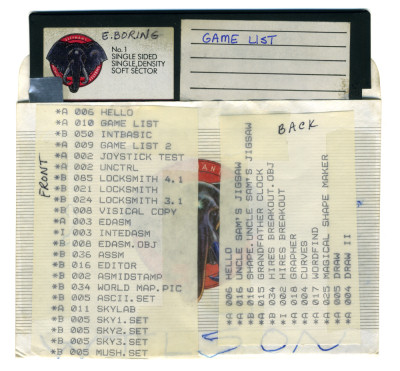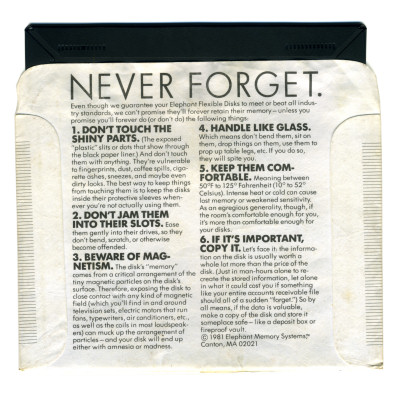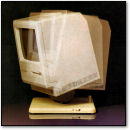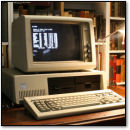[ Retro Scan of the Week ] Metadata and The Well-Loved Floppy Disk
October 12th, 2015 by Benj Edwards An elephant never forgets. [Front]
An elephant never forgets. [Front]
 Not a September 11th floppy slogan. [Back]
Not a September 11th floppy slogan. [Back]
There’s a lot of information crammed onto this Elephant Computer Systems floppy disk, and I don’t mean the digital data. It’s overflowing with external, physical clues and markings that show how it has been handled and used over its lifespan. Archivists call this “metadata” — that is, data about the data — and it is often lost when things are digitized.
The most obvious pieces of metadata from the labeling on the disk are about who manufactured it (“Elephant Computer Systems”), its optimal capacity (“single-sided, single-density”) and intended usage (“soft sector”). If you familiarized yourself with the technical specs of the floppy drives of computers available in the 5.25″ floppy era, you could rule out a few systems. That could be useful if other platform-betraying clues were absent on the disk.
Another obvious set of metadata comes from the presumed contents of the disk, which we can infer from the printed file directories taped to the disk jacket. Again, if one were familiar with the program names in the listing, one could point to a specific computer platform. (In this case, the printout looks like a DOS 3.3 “CATALOG” listing from the Apple II.)
Let’s take a step deeper into the less obvious metadata presented to us by this artifact. From visually inspecting the disk, we can tell (among other things):
1. Who Owned it and in what order
This disk and its matching jacket have two names written on it: “E. Boring” at the top, and “WILSON” scrawled lazily across the bottom of the dust jacket.
E.Boring was likely the name of the last owner of the disk, since it is at top and not covered by anything. (In this case, I know the name was “Eric Boring,” since I have his other floppiest as well — the proximity of this floppy to other labeled floppies is yet another piece of metadata.)
Was Wilson the name of a teacher? A building on a college campus? It could be the name of a previous owner before the floppy was re-purposed, or the name of the owner of the floppy jacket before it was matched up with the floppy and labeled per its contents, since the other labels cover up the Wilson name.
2. How it was held
Near the name at the top, “E. Boring,” you may notice a wear mark that comes from the thumb of the user, implying that the floppy was gripped here when being inserted and removed from a disk drive — many times, repeatedly, over the years. This also tell us something about the mechanical qualities of the drive it was used in as well. The smudging of the name also shows that it was written during or before its frequent usage.
3. Importance of the data on each side
Since it’s an Apple II disk, we know it’s an improvised double-sided disk, where each side was accessed independently by physically flipping the disk in the drive (we know it is improvised because the manufacturer’s label says “single sided”). By looking at the stickers placed over the notches on the sides of the disk, we can see that the back side (the left notch) was write-protected, but the front side (the right notch) was not — at least when it was last used (unless a sticker fell off, which happens when adhesives break down over time. In that case you will likely see adhesive residue around the notch — another metadata clue).
This could indicate that the data on the back side of the disk was considered more precious, fragile, or valuable than data on the front side. Or that programs on the front needed write access to the disk, but programs on the back didn’t.
—
We could likely go on like this for some time, extracting minutia from even more clues embedded in the appearance of this disk. It just goes to show that metadata can be critical to understanding the nature of the data contained within the disk itself. So when you’re digitizing/imaging, scan the associated physical materials as well, and always keep the originals — you never know what future generations might be able to infer from them.
Discussion Topic of the Week: Have you ever accidentally damaged a floppy disk or CD-R by writing on it?






October 13th, 2015 at 1:48 pm
It tells me that someone (Wilson perhaps?) had a disc notcher, much like i have in my desk drawer right now. It also tells me that the dsic did indeed get heavy use, most likely due to the games list #2 held on side one. The last thing this disc tells me is that someone who owned it and put data on it wanted to learn to learn to code, hence the BASIC file and Assembler file also 🙂
October 13th, 2015 at 3:26 pm
That is a cool scan. Reminds me of my days as a computer lab tech. We all had felt tip pens to avoid cracking disks.
October 17th, 2015 at 6:58 am
Most of my pre-teenhood Apple II disks/books were castoffs & backups from the computer store my stepfather worked at, and I often examined the same kinds of clues in trying to figure out what kind of person had owned them.
I never managed to damage any disks or discs just by writing on them — though I did come close by trying to notch one using large desk scissors as a kid with a horrible sense of size/proportion. It was amazing that I didn’t manage to hit the inner disc, given how massive the cuts I made were.